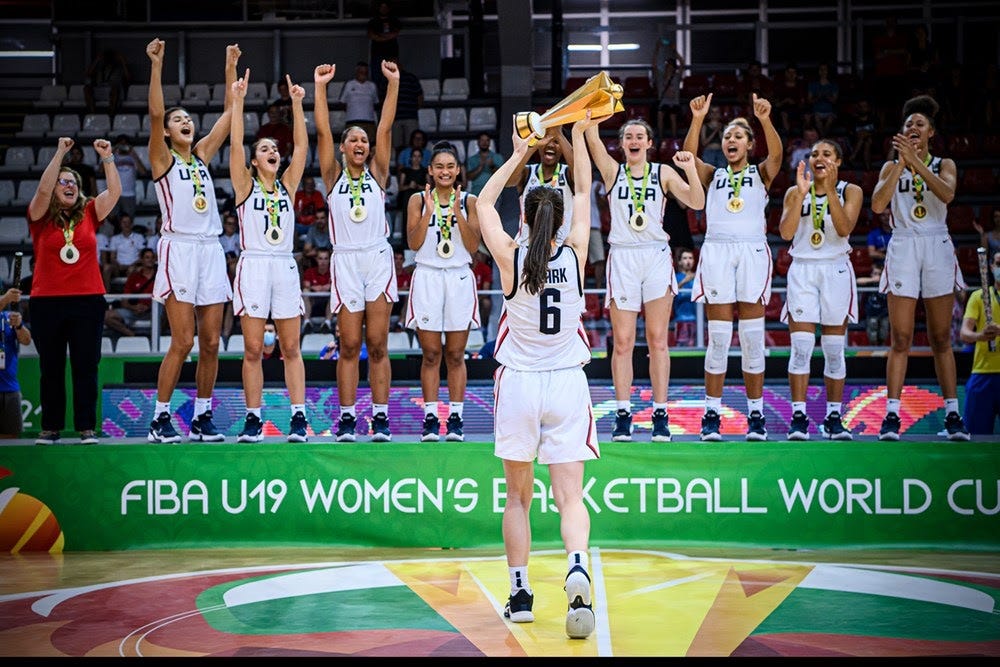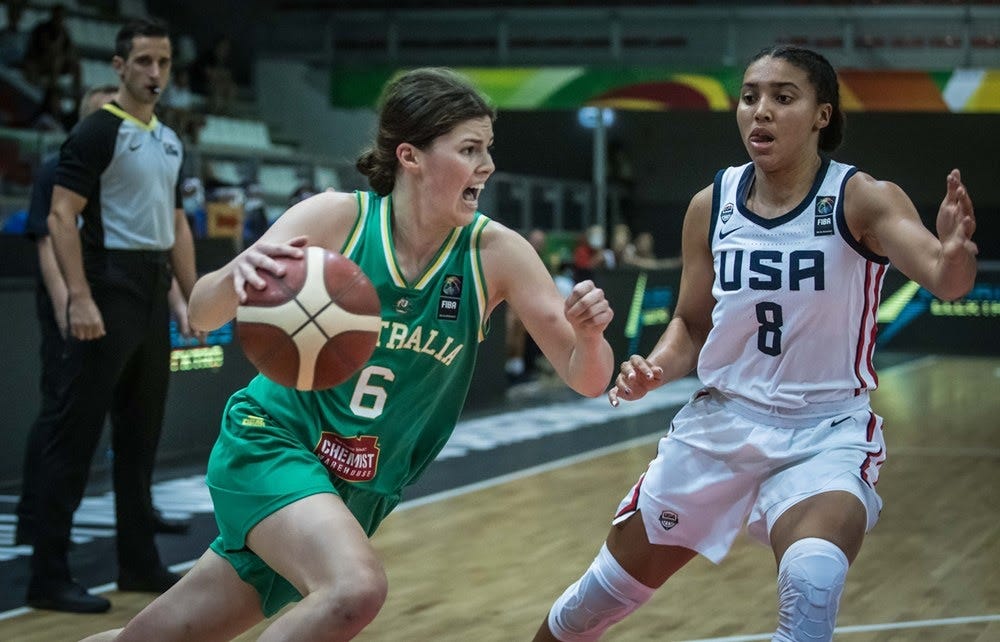What We Learned from the U19 World Cup
Observations from watching Caitlin Clark, Azzi Fudd and Team USA win gold.
Thanks for reading the Her Hoop Stats Newsletter. If you like our work, be sure to check out our stats site, our podcast, and our social media accounts on Twitter, Facebook, and Instagram. You can also buy Her Hoop Stats gear, such as laptop stickers, mugs, and shirts!
Haven’t subscribed to the Her Hoop Stats Newsletter yet?
Add another international gold medal to Team USA’s total this summer: the American women won FIBA’s Under-19 Women’s World Cup on Sunday, beating a physical Australian team 70-52 in Debrecen, Hungary.
The U.S. team, led by tournament Most Valuable Player Caitlin Clark of Iowa and a bevy of future collegians including Azzi Fudd (UConn) and Sonia Citron (Notre Dame), rolled over its initial competition during the tournament, scoring at least 96 points in each of its first five games. None of those were truly competitive, but a 75-42 semifinal win over host Hungary and the championship game provided stiffer challenges.

Coached by UCLA’s Cori Close, Team USA followed a typical pattern: control the boards, turn defense into offense and use its depth to overwhelm opponents. Hungary and Australia did their best to slow the pace, mostly by extending their halfcourt defenses, slowing down the transition game and clogging the lane. It didn’t hurt that defenders could be more physical under FIBA’s rules, especially on the perimeter (to say nothing of the variable officiating). Australia in particular tightened its defense after losing by 40 to the Americans during group play.
Here’s what we learned from watching Team USA’s seven games in August:
Guards First, and Clark First Among Them
Not surprisingly, this U.S. team was led by its guards. At times the Americans sported a lineup of Clark, Fudd, Oregon’s Te-Hina Paopao, Payton Verhulst (headed to Louisville) and the 6-7 Lauren Betts - essentially a true center and four perimeter players. Diamond Johnson, who transferred from Rutgers to North Carolina State in April, also saw significant minutes as a primary ball-handler and scored 15 points - her highest total of the tournament - in the final.
Close put the ball in Clark’s hands so she could create her own shots and find open teammates. Team USA’s opponents keyed in on Clark a few steps over half-court and she was the most likely player to end up on the floor after driving. By the knockout rounds, defenders were pushing Clark away from the middle in an attempt to reduce her passing angles. Her worst shooting performance came in the final, when she was 3-12 from the floor, including 1-5 from three-point range. Still, Clark is no stranger to dealing with defenses trying to limit her shots, and was able to get to the basket and draw fouls.
The Useful Role Players
This wasn’t a one-woman band, though, and the most consistent player may have been Citron, the only player on the team who scored in double figures every game. On a team with no shortage of scoring options, she was the second-leading scorer with 13.7 points a game and averaged 7.3 rebounds a game, good for second on the team behind Betts. She also got to the free-throw line 36 times, the most of any U.S. player (Clark had 22 free throw attempts). Citron was a key factor in the title game, playing 32 minutes and hitting two three-pointers while committing no turnovers. She joined Clark on the tournament’s “All-Star Five” team.
It’s odd to think of Fudd, the consensus top recruit, as a role player, but she often drew the assignment of guarding the opposition’s leading scorer. In the gold medal game she spent much of her time shadowing guard Jade Melbourne, who had scored 20 and 19 points in Australia’s previous two games but ended up with just seven points in the final. Melbourne previously committed to play for Arizona State, but last month signed a professional contract with an Australian team.

For UConn fans wondering how Fudd’s recovery from a severe knee injury would impact her shot, the good news is that despite a poor shooting performance against Australia, she hit 49% of her shots overall and 52% from long range. Fudd’s 13 threes were second on the team to Clark.
Johnson provided a needed change of pace on offense and excelled at getting into the lane for layups or creating her own shots. Betts (a Stanford commit) and, to a lesser extent, Arizona’s Lauren Ware, forced double-teams in the post that led to open perimeter shots. Paopao did a little bit of everything, averaging nearly 4 rebounds and 5 assists a game.
Who We Didn’t See Enough
Team USA had four true post players, but Betts and Ware played most of the minutes in the interior, leaving incoming freshmen Jersey Wolfenbarger (Arkansas) and Amari DeBerry (UConn) limited time on the court. This was a good call, results-wise: Betts was a huge advantage with her length and ability to get offensive rebounds, while Ware was steady on the boards. Sania Feagin, the South Carolina recruit, grabbed 11 rebounds in 17 minutes in the semi-finals but played just four minutes against Australia and struggled with her shooting overall.
Wake Forest’s Jewel Spear, who scored 14 in Team USA’s first win over the Czech Republic, was placed under USA Basketball’s health and safety protocols on August 8 and did not play in the remaining games.
Future NCAA or WNBA Players?
Team USA wasn’t the only one in this tournament with potential collegiate or WNBA players on its roster. In addition to Melbourne, a rest-of-the-world team from the U19 World Cup might feature these players:
Sika Kone, Mali. This 6-3 forward averaged World Cup-leading 19.7 points and 14.8 rebounds in leading Mali to a fourth-place finish. She recorded six double-doubles.
Shayanne Day-Wilson, Canada. A 5-5 guard, she played nearly every minute of Canada’s games and averaged 18 points, 5.9 rebounds and 5.7 assists. Day-Wilson decommitted from Syracuse and entered the transfer portal before the start of the World Cup.
Anastasia Olairi Kosu, Russia. Just 16 years old, this 6-1 forward led Russia in scoring and averaged a double-double.
Dominika Paurová, Czech Republic. Another 16-year-old, Paurová led her team in scoring and rebounding while only playing an average of 26 minutes a game.
Thanks for reading the Her Hoop Stats Newsletter. If you like our work, be sure to check out our stats site, our podcast, and our social media accounts on Twitter, Facebook, and Instagram.



